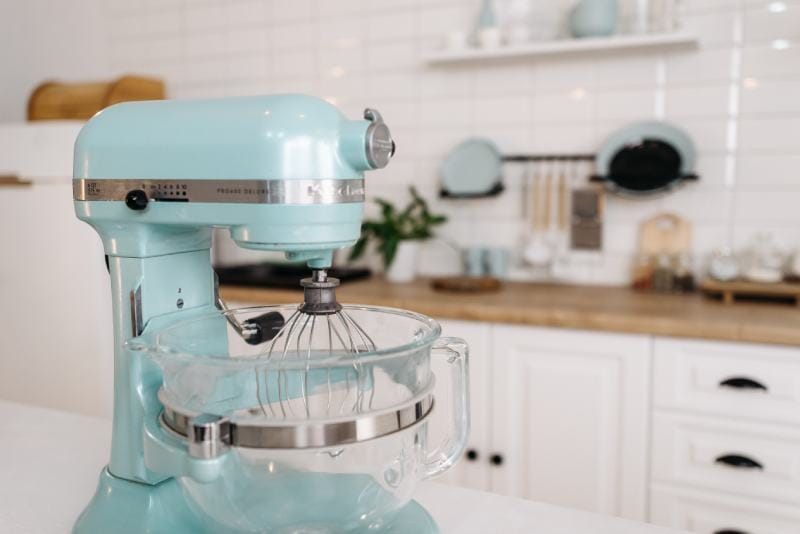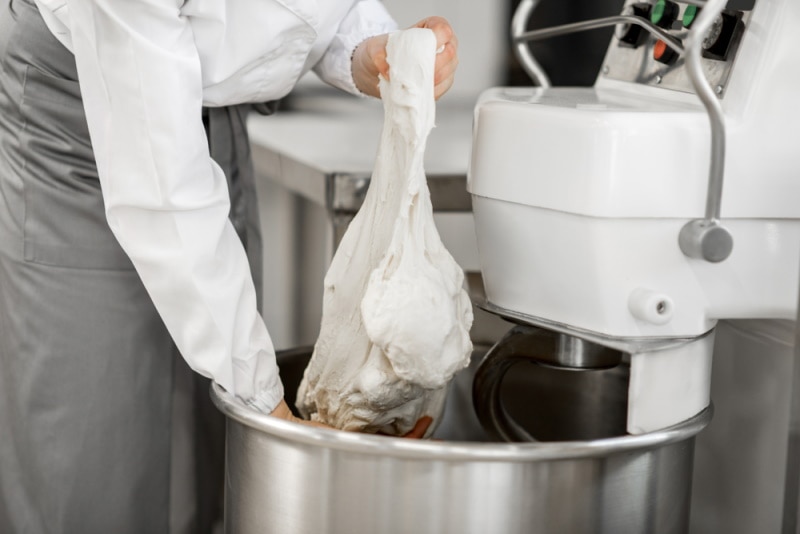Who Invented the Mixer, and When? History Explained
-
Pete Ortiz
- Last updated:

There are few household appliances as universal as the mixer. Virtually every kitchen has one and many households have multiple mixers. From home to restaurant kitchens, it’s hard to find a cooking space that doesn’t have a mixer of some sort. However, the mixer is not a new invention by any means. In fact, we can trace its origins back over 2,300 years ago but the modern mixer was invented in 1914. Let’s take a look at the history of the mixer and how we came to have so many different models in our kitchens today.
Who’s Credited for Inventing Today’s Mixer?
Herbert Johnson, an engineer who worked for Hobart Manufacturing Company, is credited with having invented today’s modern dough mixer in 1914. It was an 80-quart industrial mixer that sold quickly once it hit the market. However, the history of dough mixing is fairly long and goes back hundreds of years before today’s modern mixer was invented.

The Ancient Origins of the Mixer
By definition, an appliance is a device that is used for a specific task, usually in the home, that is not possible or not practical to do by hand. A mixer is a device that is used for mixing ingredients together, usually dough, batter, or cream.
Mixers have been used for thousands of years, dating back to the Babylonian period. Babylonian texts describe the use of bowls with rotating spindles as early as the 7th century BC, although it’s unlikely that the rotating spindles were powered by hand. Mixing bowls have been found in Egyptian tombs that are more than 4,000 years old.
The mixing bowls were made of stone, shaped like a mixing bowl, with a pour spout in the center and a small hole in one side. The Egyptians are thought to have used these bowls to mix various foods and drugs, including cosmetics, while the hole in one side was used to pour the contents of the bowl.
The Development of Dough Kneading Machines
Restaurants began to emerge in the mid-1700s and by the mid-1800s, commercial restaurants had become common in large cities. As restaurants began to rise in popularity, the demand for baked goods increased and bakers began to experiment with ways to make a lighter loaf, using a variety of methods.

If they didn’t have access to a modern mixer, bakers would naturally form the dough into loaves, pressing it, twisting it, and then pressing it again. The bakers would then place the dough in a large wooden frame and manually turn the dough, using the turning of the frame to knead the dough. However, this was a very time-consuming and labor-intensive process and couldn’t be done on a large scale.
The Invention of the Beater-Mixer
The first patent for a paddle-type beater-mixer was issued in 1877, but it didn’t become a common appliance until the turn of the century. While beater-mixers were much easier to use than wooden frame, they didn’t eliminate the need for manual labor. Bakers still needed to manually turn the dough with a wooden paddle and shunt the dough back and forth. These early models were also quite heavy, making them very difficult to use by hand.
The Rise of the Stand Mixer
As the Industrial Revolution came to a close, the demand for a lighter loaf of bread increased, which resulted in the invention of the first electric stand mixer. With the invention of the electric motor, it became possible to create an electric stand mixer that allowed bakers to simply put the ingredients in the machine and turn a knob, eliminating the need for manual labor.
The stand mixer combined the paddle-type mixer with a dough hook. While it was an improvement on the paddle-type mixer, it was still too heavy to be operated by hand. However, the invention of the first electric motor in the 1920s made it possible to produce a stand mixer that was light enough to be operated by hand.

Advantages of Owning a Bread Maker
A bread machine is an appliance that will knead, mix, and bake your dough for you – something your hands and forearms will thank you for. This can be a great time-saving solution for those who love fresh-baked loaves but don’t really have the time to do it by hand. A bread maker will take care of all the hard work of kneading, rising, and baking. You simply need to put the ingredients into the machine and press a few buttons.
The machine will do all the work for you so that you can be left with a fresh and delicious loaf of bread at the end of the day. Bread mixers make baking bread a much simpler process. They mix the ingredients thoroughly and make sure that everything is properly combined. They also knead the dough, which is a necessary part of baking a loaf. You’ll be able to enjoy fresh and delicious loaves of bread at home thanks to a bread mixer.
Types of Bread Mixers
There are a few different types of mixers available nowadays. Let’s take a look at the main ones.
- Manual Bread Mixer: A manual bread mixer is actually the cheapest and most basic type of mixer. It consists of a typical mixing bowl and a handle, with which you have to manually turn to mix the ingredients. This type of mixer is very basic and offers the least number of benefits. But if you want to knead dough manually, this may be a good choice.
- Stand Mixer: A stand mixer is one of the most popular types of mixers. It includes a bowl, a motor, and a few different attachments to help you make different types of dough. They’re very versatile and can be used for more than just baking bread. You can also use a stand mixer to make things like pasta, mashed potatoes, and more.
- Handheld Mixer: A handheld mixer is another versatile tool that you can use to mix dough, as well as mix ingredients together. This type of mixer is great for smaller batches. You can use it to mix ingredients for foods including cookies, muffins, and more.

Things to Consider When Buying a Bread Mixer
There are a few things that you should consider when buying a bread mixer. These things will help you to find the best one for your needs. Let’s take a look at some of them.
Bread Capacity
The first thing to consider is the size of the machine. Meal mixers come in a range of different sizes, and each one is designed to make a certain amount of bread loaves. You want to make sure that you choose one that is big enough for your needs.
Type of Machine
Another important consideration when buying a mixer is the type of machine that you buy. There are two types of mixers available, and they each have their own set of advantages. A stand mixer is great because it has multiple attachments that can be used for different purposes. But a handheld machine is great for smaller batches.
Wattage
The wattage of the machine is another important thing to consider. A higher wattage means that the machine will be more powerful, which means that it’ll be able to mix thick dough much better. When you’re accustomed to making bread that calls for thick, dense dough, a higher wattage is an absolute must.

Online Reviews
It’s always great to check out online reviews before buying anything, and that includes mixers. Check out sites like Yelp, YouTube, and Facebook to get some idea of what everyone else is saying about the mixer before you buy it. Be sure to also look at home warranties, similar competitors, and refund policies as well.
How Much Do Bread Mixers Cost?
The price of a mixer varies depending on the brand and model that you choose. A basic manual mixer may cost as little as $30-40, while an automatic machine with a lot of additional features may cost up to $200. And remember, as with most kitchen appliances, you get what you pay for. The more expensive mixers usually have a number of advanced features and are built to last. But you can expect to pay about $200-300 on average for a decent machine.
Wrapping Things Up
The mixer is one of the most useful and versatile appliances in the kitchen. From mixing ingredients to kneading dough to whipping cream, there are few tasks that a mixer can’t do. This amazing machine has been in use since the 17th century, with the first electric mixer available since the early 1900s.
The mixer has evolved greatly since its inception, from being a bulky, heavy device that required manual labor to being a light, modern appliance that can do everything from mixing cake batter to making mashed potatoes.
Featured Image Credit: New Africa, Shutterstock
Contents


